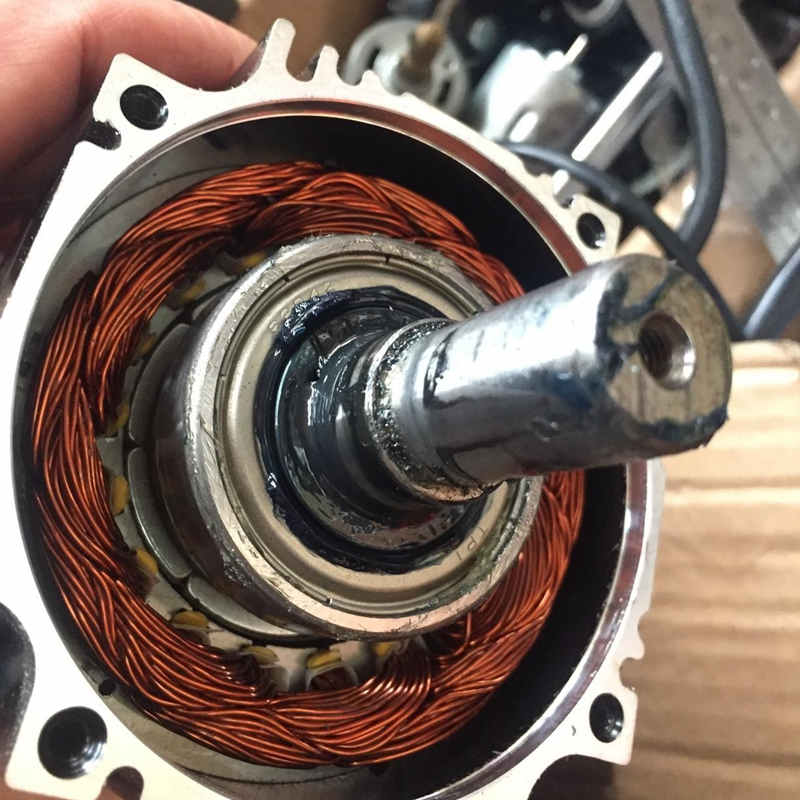Motor Bearing Overheating

Motor Bearing Overheating’s Damage:
Motor bearing overheating when the motor is running is a common fault. The reasons may vary, and sometimes it is difficult to find out the accurate reason.
Therefore, in many cases, if it is not handled in time, the damage of the motor is more serious, which shortens the life of the motor and affects normal production.
Common Factors and Solutions for Motor Bearing Overheating:
1. The rolling bearing is installed incorrectly, and the fit tolerance is too tight or too loose.
Solution: The performance of bearing not only depends on the manufacturing accuracy, but also depends on the dimensional accuracy, shape tolerance and surface roughness of the shaft and hole matched with it, the selected fit, and whether the installation is correct. In general horizontal motors, a well-assembled rolling bearing can only bear radial stress. However, if the inner ring of the bearing and the shaft are too tight, or the outer ring of the bearing and the end cover are too tight, that is, when the surplus is too large, the assembly will be will make the bearing clearance become too small, sometimes even close to zero. In this way, the rotation is not flexible, and heat will be generated during operation.
Usually, the standard moves the bearing inner ring inner diameter tolerance zone as the reference part to below the zero line. The fit between the tolerance zone of the same shaft and the bearing inner ring is much tighter than the fit formed by the general reference hole.
2. Inappropriate selection of grease, improper use and maintenance, poor quality or deterioration of grease, or mixing of dust and impurities can cause bearing overheating.
Solution: Adding too much or too little grease will also cause the bearing to heat up, because when the grease is too much, there will be a lot of friction between the rotating part of the bearing and the grease, and when the grease is too little, dryness may occur. Heat due to friction. Therefore, the amount of grease must be adjusted to approximately 25% to 35% of the volume of the bearing chamber. The unsuitable or deteriorated grease should be cleaned and replaced with a suitable clean grease.
3. The axial gap between the outer bearing cap of the motor and the outer circle of the rolling bearing is too small.
Solution: Large and medium-sized motors generally use ball bearings at the non-shaft extension end. The shaft extension end adopts roller bearings, so that when the rotor is heated and expands, it can extend freely. Since the small motor adopts ball bearings at both ends, there should be a proper gap between the outer bearing cover and the outer ring of the bearing. Otherwise, the bearing may generate heat due to excessive thermal elongation in the axial direction. When this phenomenon occurs, the front or rear bearing cover should be removed, or a thin paper pad should be added between the bearing cover and the end cover, so that there is enough space between the outer bearing cover at one end and the outer ring of the bearing.
4. The end covers or bearing covers on both sides of the motor are not installed properly.
Solution: If the end caps or bearing caps on both sides of the motor are not installed parallel or the stop is not tight, the ball will deviate from the track and rotate and generate heat. The end caps or bearing caps on both sides must be re-installed flat, and evenly rotated and tightened with bolts.
5. Balls, rollers, inner and outer rings, ball racks are severely worn or metal peeling off.
Solution: The bearing should be replaced at this time.
6. Poor connection with load machinery.
The main reasons are poor assembly of the coupling, excessive belt tension, inconsistency with the axis of the load machine, too small diameter of the pulley, too far from the bearing, excessive axial or radial load, etc.
Solution: Correct the incorrect connection and avoid the bearing from being subjected to abnormal forces.
7. The shaft is bent.
Solution: Bearing force is no longer pure radial force, which causes the bearing heat up. Try to straighten the bent shaft or replace it with a new one.
Contact Us:
If you have any questions about motor bearing overheating, please feel free to contact us.
We provide complete set of bearing solution, including design, manufacturing, sale, customization, technical support.

